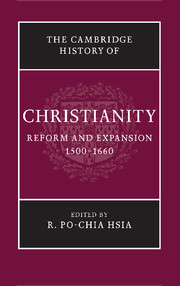Book contents
- Frontmatter
- Part I Luther and the Holy Roman Empire
- Part II The Second Reformation
- Part III Catholic Renewal
- Part IV Resolving Confessional Conflicts
- 13 Peace without concord: religious toleration in theory and practice
- 14 Imposing church and social discipline
- 15 Persecutions and martyrdom
- 16 The Mediterranean Inquisitions of early modern Europe
- 17 Religious colloquies and toleration
- 18 Western Christianity and Eastern Orthodoxy
- Part V Religion, Society, and Culture
- Part VI Christianity and Other Faiths
- Bibliography
- Index
- References
17 - Religious colloquies and toleration
from Part IV - Resolving Confessional Conflicts
Published online by Cambridge University Press: 28 March 2008
- Frontmatter
- Part I Luther and the Holy Roman Empire
- Part II The Second Reformation
- Part III Catholic Renewal
- Part IV Resolving Confessional Conflicts
- 13 Peace without concord: religious toleration in theory and practice
- 14 Imposing church and social discipline
- 15 Persecutions and martyrdom
- 16 The Mediterranean Inquisitions of early modern Europe
- 17 Religious colloquies and toleration
- 18 Western Christianity and Eastern Orthodoxy
- Part V Religion, Society, and Culture
- Part VI Christianity and Other Faiths
- Bibliography
- Index
- References
Summary
It is paradoxically from a double absence that the history of toleration and coexistence between confessions during the Reformation can be written. Not only were its partisans and artisans few in number, so much so that traditional historiography always seems to enumerate the same names – Erasmus, Schwenckfeld, Franck, Celsi, Castellion, Coornhert, or Hoen – and their texts just as rare and confidential, but the very vocabulary in which they evoked questions that seem to us to concern directly liberty of conscience and worship, protection of clerics, religious buildings and burials, and confident dialogue between members of different faiths, is a far cry from our own. ‘Toleration’, for example, is very seldom found, in French or in German, except with a negative connotation such as Luther and most of the French authors gave it in 1542: to tolerate is to endure, suffer, and accept in bad faith something that cannot be fixed or abolished in the immediate future. Significantly, the expression ‘tolerate’, or ‘toleration’, cannot be found in the texts that concretely organized the great experiments of peaceful coexistence in the Empire or in France: these terms are absent from the texts of the Peace of Augsburg (1555), from most of the Landesordnungen, as well as from the Edict of Nantes (1598). When they evoked the possibility of establishing a form of coexistence between rival confessions that vied for control in Europe from the beginning of the 1520s, contemporaries willingly spoke of concordia, of mansuetudo, caritas or, in a different register and often with different intentions, of pax and amicitia.
- Type
- Chapter
- Information
- The Cambridge History of Christianity , pp. 302 - 320Publisher: Cambridge University PressPrint publication year: 2007

